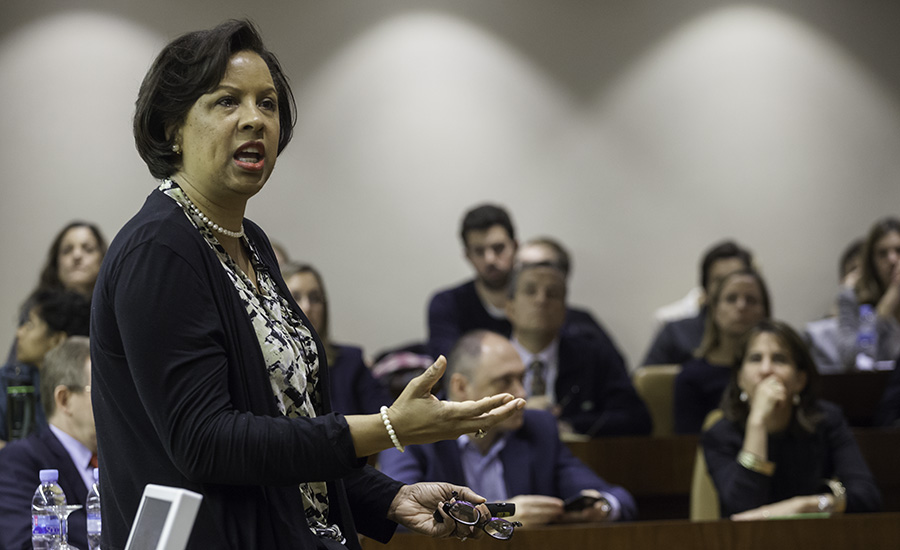
Using the cloud to empower all individuals and organizations across the globe is part of Microsoft’s new narrative – the company’s Corporate Vice President of the Worldwide Public Sector, Toni Townes-Whitley, told IESE MBAs and alumni at a session this week.
Townes-Whitley used last September's UN-brokered agreement to tackle 17 of the world's most pressing problems as the starting point for her company's new vision.
Solving the World’s Problems is Good for Business
The agreement was signed by 193 world leaders and, among other pressing challenges, pledges to eliminate poverty, hunger and lack of economic development by 2030. According to Townes-Whitley, unleashing the enormous computing power of the cloud will be a key factor in making at least some of it possible.
Not only possible, but also profitable. Townes-Whitley cites a figure of $2.1 trillion USD to fulfill all 17 of the Sustainable Development Goals (SDG) agreed in September 2015. Microsoft itself has committed to tackle eight of the SDGs through a strategy of:
- Engaging citizens
- Empowering employees
- Optimizing infrastructure
- Transforming public services
“We can do good things for good money,” asserts Townes-Whitley.
Connections, Context and the Cloud
The key to implementing this strategy is deploying the incredible analytical potential of cloud computing. Once you have such a deep level of analysis, says Townes-Whitley, you can identify hidden patterns and context, from which solutions can evolve.
Take the case of health care: Microsoft scientists recently showed that by analyzing large samples of search engine queries they could identify internet users suffering from pancreatic cancer, even before they had received a diagnosis of the disease.
Or transport: In South Africa, an app-based solution is allowing citizens to engage directly with the local authorities to alert and help solve issues with the country’s infrastructure. They can even help formulate policies for improving transport.
Challenges for the Next Industrial Revolution
But what has been dubbed ‘The Forth Industrial Revolution’ is not without its potential downside. This is something Townes-Whitley is keen to highlight, underlining the need to preempt and tackle four key challenges of the new digital order:
- Job displacement
- Diminishing privacy
- Greater income inequality
- Lack of access to technology
Gender inequality is an ongoing preoccupation for Townes-Whitley that spans a few of these challenges. She pointed out that, while women have attained near parity across the board in education, there is still much work to be done in the workplace, where women only fill 36% of leadership roles.
There is a concern that the transformations wrought by new technologies could make the situation worse, rather than better.
Heading Off Increasing Inequality
For every job created by the new digital economy, four old economy roles predominantly filled by men will be destroyed, predicts Townes-Whitley. In the case of those jobs mainly done by women, the figure rises to 20.
Training and inclusion programs are essential for correcting this potentially disastrous turn of events. They will also need to be deployed to the max if the 60% of the world’s population who are not currently participating in the digital economy are not to be left behind entirely.
Combining New Thinking with Traditional Values
Ensuring that the cloud is not a vehicle for imposing a one-size-fits-all model on a diverse world is a challenge Microsoft is aware of. To quote CEO Satya Nadella: “Our customers and society expect us to maximize the value of technology while also preserving the values that are timeless.”
Townes-Whitley knows only too well that imposing solutions on societies can lead to unforeseen, and sometimes adverse, effects. As a volunteer in an Africa village she used water-harvesting techniques to avoid the need for a five-mile trek to the nearest well.
It was only later that she realized the women of the village saw the daily journey as an opportunity to bond with each other, not as an unnecessary chore. The imposition of new technology had inadvertently eliminated an important cultural element of village life – something Microsoft says it is seeking to avoid.
Wanted: MBAs Who Can Join the Dots
So what sort of expertise is the newly directed Microsoft in search of to help make its dream of global improvements for all a reality?
“Cloud computing is about joining the dots to create context. We need minds that can do that, more than ever,” says Townes-Whitley, who advises IESE MBAs to pursue cross-discipline studies as much as possible, and practice “horizontal thinking.”
Given that Microsoft is relying on a vast partner ecosystem to deliver its vision, and has a number of competitors in the market, it seems the cloud may soon be giving many of us the chance to do good – and for good money.